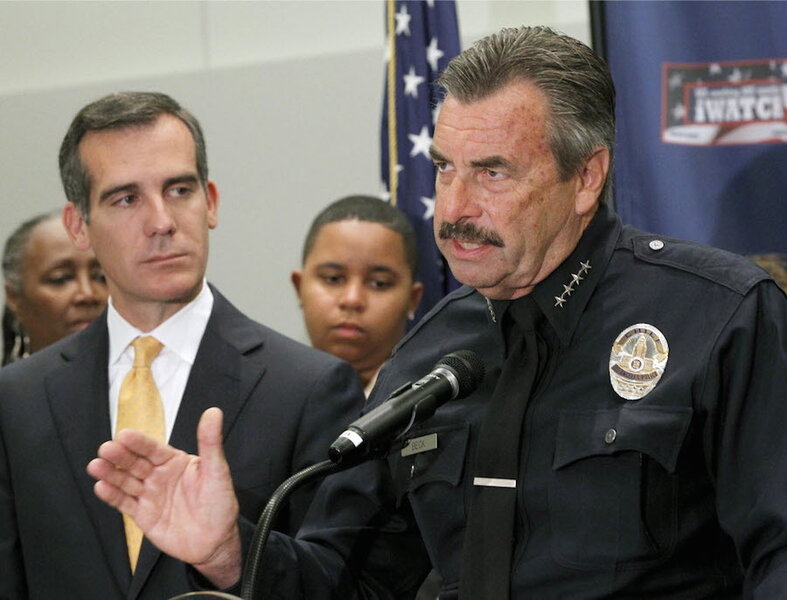Los Angeles responds to rising 2015 crime rates
Loading...
The Los Angeles Police Department (LAPD) will continue to crack down on “hot spots” after statistics show a notable rise in crime rates – all except murders – in the first half of 2015.
The city witnessed a steady decline in crime since 2003, yet the first six months of this year saw a 12.7 percent increase in overall crime, The Los Angeles Times reports.
Mayor Eric Garcetti and Los Angeles Police Chief Charlie Beck pointed to a few factors that could explain the rise, such as gang violence, an escalation in homelessness, and a ballot measure passed in November that reduced felony drug possession and thefts to misdemeanors.
According to the LAPD, violent offenses saw a 20.6 percent increase while property crime saw a 10.9 percent increase, driven by an overall rise in burglaries, thefts and motor vehicle thefts.
“This is bad news,” Mayor Garcetti said Wednesday. “Let me be clear: Any uptick in crime is unacceptable.”
Department statistics showed that gang-related activity has risen by 18.3 percent. In hopes of reducing the climbing number, Police Chief Beck announced in April that he would deploy more than 200 highly trained officers from the Metropolitan Division to high-crime neighborhoods. The move was a difficult step to take, as the LAPD has been trying to build trust and better relationships with those communities after years of tensions between the two.
Beck said the department’s latest strategy would utilize data to inform its “predictive policing”, a tactic that would boost existing approaches such as problem-oriented policing, community policing, intelligence-led policing and hot spot policing.
According to Beck, “homeless-on-homeless” incidents make up most of the crime in the police department’s Central Division. The city’s homeless population has increased by 16 percent since 2013, according to a Los Angeles Homeless Services Authority report released in May.
All types of offenses, except for homicide, have increased. Yet Garcetti noted that higher property crime in particular might be a result of Proposition 47, also known as the “Safe Neighborhoods and Schools Act," a ballot measure that downgraded minor offenses such as drug possession and thefts from felonies to misdemeanors.
The act was passed in November and has since led to the release of approximately 3,700 inmates from the state prison. According to states prison chief, Jeffrey Beard, its legislation resolved one of the state’s key problems: prison overcrowding.
“The good news is we’ve addressed our jail overcrowding situation in California, which wasn’t acceptable to anybody,” San Francisco Police Chief Greg Suhr told the San Francisco Chronicle. “The thing we are grappling with is the tremendous rise in property crime.”
But some say that isn’t the worst-case scenario.
Peter Moskos, a criminologist at the John Jay College of Criminal Justice in New York, told the Los Angeles Times that the rise “may be an acceptable trade-off for taking a less strict approach toward relatively minor crimes.”
“If there is huge money saved in incarceration,” he said, “I think we can take an increase in property crimes.”
Both Beck and Garcetti stressed that while crime is still high, it’s declined slightly since the first three months of the year.
Los Angeles isn't the only city to see a recent jump in the crime rate after years of steady declines. But as The Christian Science Monitor reports:
While triple digit percentage increases in Milwaukee and a more than 50 percent jump in Houston might make for arresting headlines, criminal justice experts say they don’t currently see a reason for the public to be alarmed. For one thing, part of the reason the [crime increase] percentages look so high is because violent crime, including murder, has dropped so much since the 1990s. (For example, Milwaukee saw 63 murders through May, up from 31 in 2014 – but that is still well below the average from the 1990s.) And it is not at all clear that this is the beginning of a long-term increase.
“I think it’s unfortunate when the media talks a lot about these crime spikes.... It tends to scare the public,” says Inimai Chettiar, director of the Justice Program at the Brennan Center for Justice at the New York University School of Law. “A lot of people don’t even know there was a massive crime decline.”
Ms. Chettiar says she does not currently see signs of a long-term trend in increasing violence in the US.






